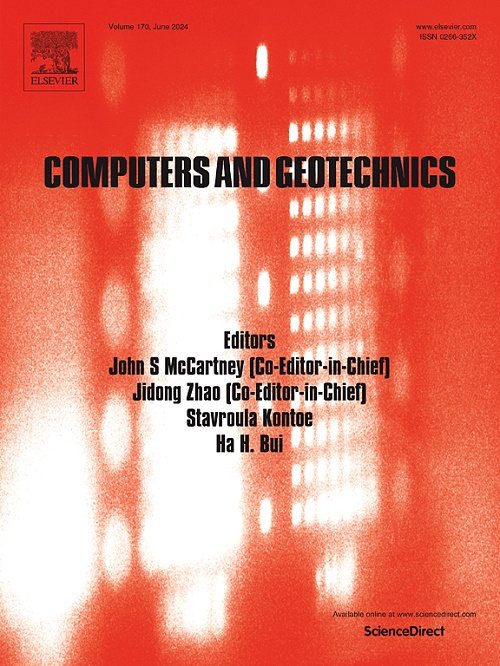A 1-D model to describe the suction anchor–soil plug interaction under sustained uplift loads
IF 5.3
1区 工程技术
Q1 COMPUTER SCIENCE, INTERDISCIPLINARY APPLICATIONS
引用次数: 0
Abstract
We present a one-dimensional model, based on displacement compatibility and continuity of the water mass equations, to describe the mechanical and hydraulic interaction at the contact between the caisson lid and the soil plug during the uplift process of a suction caisson. The model has been specifically conceived as an alternative to the technique based on the use of a layer of poroelastic FE, widely presented in the literature and referred to as water elements. The proposed model, which depends on two parameters having a clear physical meaning, has been encoded in a Fortran-based UAMP subroutine and used in an incremental FE procedure to simulate the progressive sliding failure of a caisson under sustained loads. The results, which are in very good agreement with previous numerical studies based on the use of the water elements, are also compared with those obtained from a simplified numerical approach, in which a bonded lid–plug contact is considered. The comparison is presented to further assess the effectiveness of the proposed 1-D model and to highlight the limitations of the simplified method, clarifying the extent to which these simplifications can be deemed acceptable for engineering purposes.
我们提出了一个基于位移相容性和水质量连续性方程的一维模型,用于描述吸水沉箱在上浮过程中沉箱盖与土塞接触处的机械和水力相互作用。该模型的设计初衷是为了替代文献中广泛介绍的基于孔弹性 FE 层的技术,即水元素。所提议的模型取决于两个具有明确物理意义的参数,已被编码到基于 Fortran 的 UAMP 子程序中,并被用于增量 FE 程序,以模拟沉箱在持续载荷下的渐进式滑动破坏。模拟结果与之前基于水元素的数值研究结果非常吻合,同时还与简化数值方法得出的结果进行了比较,其中考虑了粘结盖板-塞子接触。进行比较的目的是进一步评估所提出的一维模型的有效性,并强调简化方法的局限性,同时澄清这些简化在多大程度上可被视为工程上可接受的方法。
本文章由计算机程序翻译,如有差异,请以英文原文为准。
求助全文
约1分钟内获得全文
求助全文
来源期刊

Computers and Geotechnics
地学-地球科学综合
CiteScore
9.10
自引率
15.10%
发文量
438
审稿时长
45 days
期刊介绍:
The use of computers is firmly established in geotechnical engineering and continues to grow rapidly in both engineering practice and academe. The development of advanced numerical techniques and constitutive modeling, in conjunction with rapid developments in computer hardware, enables problems to be tackled that were unthinkable even a few years ago. Computers and Geotechnics provides an up-to-date reference for engineers and researchers engaged in computer aided analysis and research in geotechnical engineering. The journal is intended for an expeditious dissemination of advanced computer applications across a broad range of geotechnical topics. Contributions on advances in numerical algorithms, computer implementation of new constitutive models and probabilistic methods are especially encouraged.
 求助内容:
求助内容: 应助结果提醒方式:
应助结果提醒方式:


